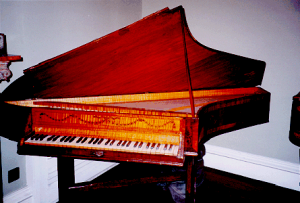Harpsichord music
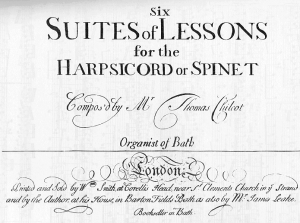
- Six Suites of Lessons for the Harpsichord or Spinet
- [click on the picture to enlarge it]
The major form of early eighteenth-century English solo harpsichord music was the suite, where the influence of French style can be detected, with a set of dances following an introductory prelude or overture. Thus, Thomas Chilcot, organist at Bath, typically published Six Suites of Lessons for the Harpsichord or Spinet (1734), which consist of a traditional combination of allemandes, courantes, jigs, and sarabands, together with fashionable minuets. Naturally enough, the pieces are dedicated to a lady, since the harpsichord was essentially a female instrument; they could also be played on the spinet, a smaller instrument.
After the London publication of Domenico Scarlatti’s works for the harpsichord, however, the suite gave way to the sonata, in which the influence of Italian style could be felt.
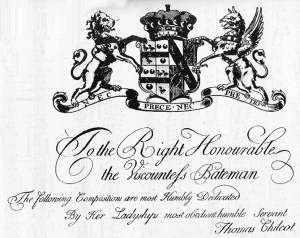
- Dedicace to a lady
- [click on the picture to enlarge it]
The harpsichord also played a major part as a continuo instrument, particularly in chamber music. Arguably, the apparently ancillary art of providing musical accompaniment in a domestic environment matched the social role conventionally assigned even to women of distinction.
The harpsichord was later in competition with the pianoforte.
A harpsichord is shown in Zoffany’s painting of the Sharp family.
Harpsichord or spinet ?
A tune could be played either on the harpsichord ...
- Purcell, Hornpipe on harpsichord
- record The Purcell Manuscript (1995) with Davitt Moroney on harpsichord
Virgin Classics, VC 5 45166 2, track 13
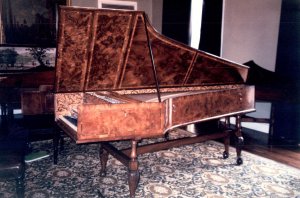
- Harpsichord
- Kickerman 1755 Londres 1
[click on the picture to enlarge it]
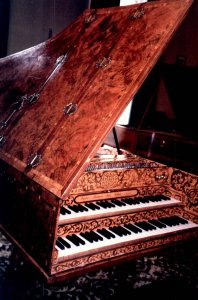
- Harpsichord
- Kickerman 1755 Londres 2
[click on the picture to enlarge it]
...or on the spinet.
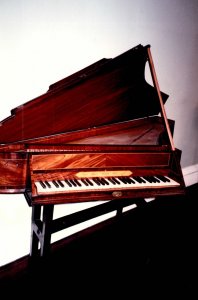
- Spinet
- Baher Harris Loln 1776
[click on the picture to enlarge it]
- Purcell, Hornpipe in E minor (Z T685) on spinet
- record The Gresham Autograph (1995) with Gary Cooper on spinet
CD ASV, GAU 194, track 16
The sound differs.
Pianoforte or fortepiano
The first version of the piano, a keyboard instrument in which the strings are struck with hammers, so that it is possible to produce many more dynamic variations by finger pressure than on a harpsichord or spinet, in which the string is only plucked, had been invented in Italy ca. 1700, then moved on to Germany. Whether it was called fortepiano or pianoforte, the name underlined the specificity of an instrument that could play loudly or softly.
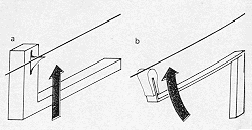
- Pianoforte
- Diagram showing the plucking action of the harpsichord jack (a) and the striking action of the piano hammer (b)
[click on the picture to enlarge it]
- Mozart, Andante K501
- played on an English fortepiano of 1772 in St Cecilia’s Hall, 1980, copyright The Friends of St Cecilia’s Hall, LP record SCH801 Music for Two harpsichords, Clavichord and Fortepiano played by Lucy Carolan and Peter Williams.
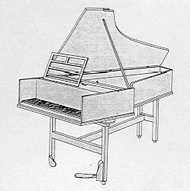
- Broadwood English action piano, 1792
- [click on the picture to enlarge it]
Not until the latter part of the eighteenth century, when the “industrial revolution” made heavier strings available, that were better suited to hammering than the light strings used on harpsichords and spinets, did the pianoforte gain recognition. In 1760 the German manufacturer Johannes Zumpe, who emigrated to Shudi’s harpsichord workshop at the time of the Seven Years’ war, took the art of piano making to England, where he developed a compact “square” piano with a rectangular case. Public performances on the new instrument were first heard by London audiences in 1767 and 1768. Later in the century, John Broadwood introduced his “English” action pianos.
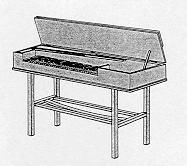
- Square piano by Johannes Zumpe, 1767
- The first public solo piano performance was by J.C. Bach on a Zumpe piano in England in 1768
[click on the picture to enlarge it]
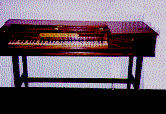
- Square piano
- [click on the picture to enlarge it]
Although harpsichord makers tried to face competition with the new instrument by introducing devices, such as the Venetian swell, that provided greater dynamic flexibility, the piano became increasingly popular. Kirckman’s workshop reputedly produced its last harpsichord in 1809.
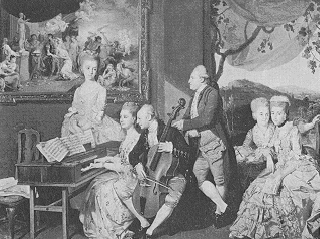
- Zoffany, The Cowper and Gore families (1772-76) showing a square piano, probably by Zumpe.
- Lady Salmon, Henfield, Sussex, in H. Rice Hollis, The Piano: A Pictorial Account of its Ancestry and Development (1975)
[click on the picture to enlarge it]

